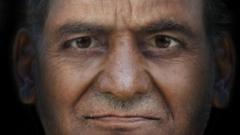Recent archaeological findings near Keeladi in Tamil Nadu state have unveiled a significant glimpse into ancient South Indian life, specifically through the discovery of human remains and artifacts dating back approximately 2,500 years. Among the unearthed items were several human skulls, found meticulously placed within massive burial urns alongside other goods, offering valuable insights into the funerary practices and material culture of the period.
These ancient skulls have become the focus of an innovative research initiative aimed at bringing the faces of these long-deceased individuals back to life. Utilizing advanced forensic anthropological techniques and cutting-edge digital reconstruction methods, researchers embarked on a complex process to recreate the probable facial features of these inhabitants from millennia past. The methodology typically involves detailed analysis of the skull’s bone structure, noting specific anatomical markers, muscle attachment points, and cranial contours. This information is then used to digitally sculpt soft tissue layers, often guided by established databases on human anatomy and tissue depth. The reconstruction efforts provide a scientific interpretation of what these individuals might have looked like, offering a powerful visual connection to a civilization that flourished thousands of years ago. Such endeavors not only deepen our understanding of ancient human appearance but also contribute to broader studies of population genetics, health, and cultural identity in ancient India.



